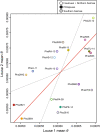High levels of inbreeding with spatial and host-associated structure in lice of an endangered freshwater seal
- PMID: 35726520
- PMCID: PMC9544963
- DOI: 10.1111/mec.16569
High levels of inbreeding with spatial and host-associated structure in lice of an endangered freshwater seal
Abstract
Host-specialist parasites of endangered large vertebrates are in many cases more endangered than their hosts. In particular, low host population densities and reduced among-host transmission rates are expected to lead to inbreeding within parasite infrapopulations living on single host individuals. Furthermore, spatial population structures of directly-transmitted parasites should be concordant with those of their hosts. Using population genomic approaches, we investigated inbreeding and population structure in a host-specialist seal louse (Echinophthirius horridus) infesting the Saimaa ringed seal (Phoca hispida saimensis), which is endemic to Lake Saimaa in Finland, and is one of the most endangered pinnipeds in the world. We conducted genome resequencing of pairs of lice collected from 18 individual Saimaa ringed seals throughout the Lake Saimaa complex. Our analyses showed high genetic similarity and inbreeding between lice inhabiting the same individual seal host, indicating low among-host transmission rates. Across the lake, genetic differentiation among individual lice was correlated with their geographic distance, and assignment analyses revealed a marked break in the genetic variation of the lice in the middle of the lake, indicating substantial population structure. These findings indicate that movements of Saimaa ringed seals across the main breeding areas of the fragmented Lake Saimaa complex may in fact be more restricted than suggested by previous population-genetic analyses of the seals themselves.
Keywords: Saimaa ringed seal; conservation genomics; genome resequencing; host-parasite interactions; seal louse.
© 2022 The Authors. Molecular Ecology published by John Wiley & Sons Ltd.
Conflict of interest statement
The authors declare no competing interests.
Figures



Comment on
-
Consistent signatures of urban adaptation in a native, urban invader ant Tapinoma sessile.Mol Ecol. 2022 Sep;31(18):4832-4850. doi: 10.1111/mec.16188. Epub 2021 Oct 5. Mol Ecol. 2022. PMID: 34551170
References
-
- Allen, J. M. , Boyd, B. , Nguyen, N. P. , Vachaspati, P. , Warnow, T. , Huang, D. I. , Grady, P. G. S. , Bell, K. C. , Cronk, Q. C. B. , Mugisha, L. , Pittendrigh, B. R. , Leonardi, M. S. , Reed, D. L. , & Johnson, K. P. (2017). Phylogenomics from whole genome sequences using aTRAM. Systematic Biology, 66, 786–798. - PubMed
Publication types
MeSH terms
LinkOut - more resources
Full Text Sources

